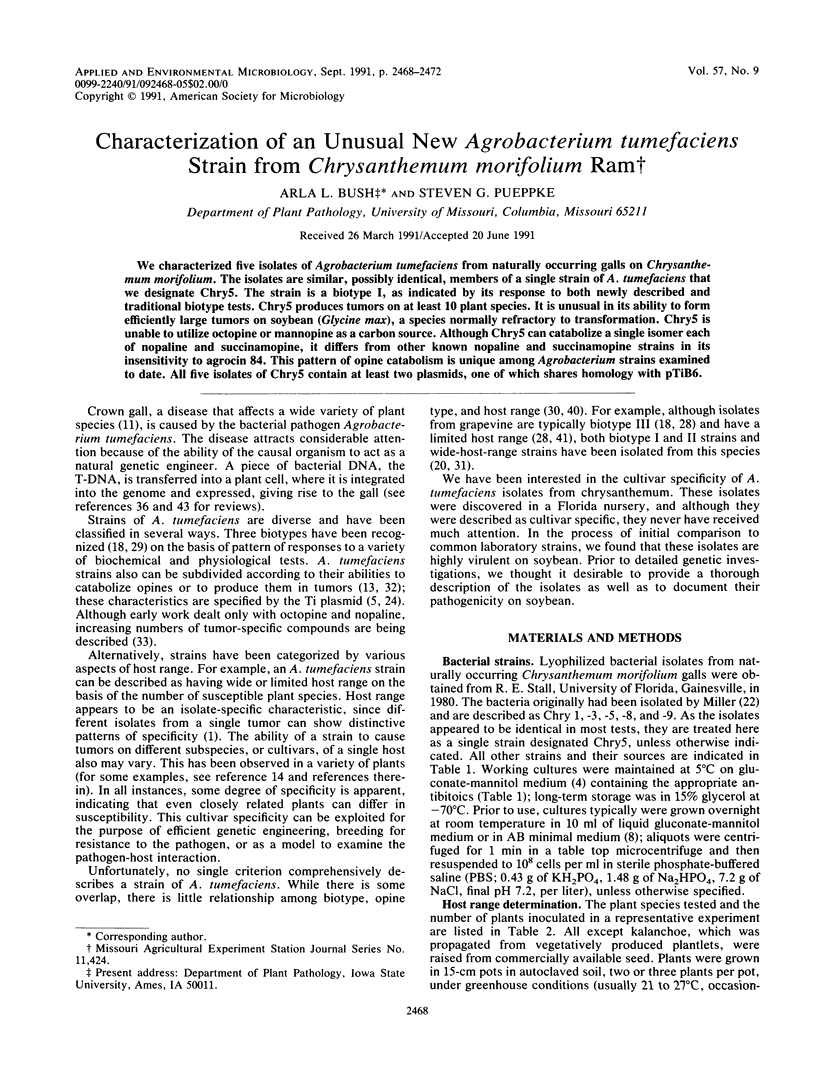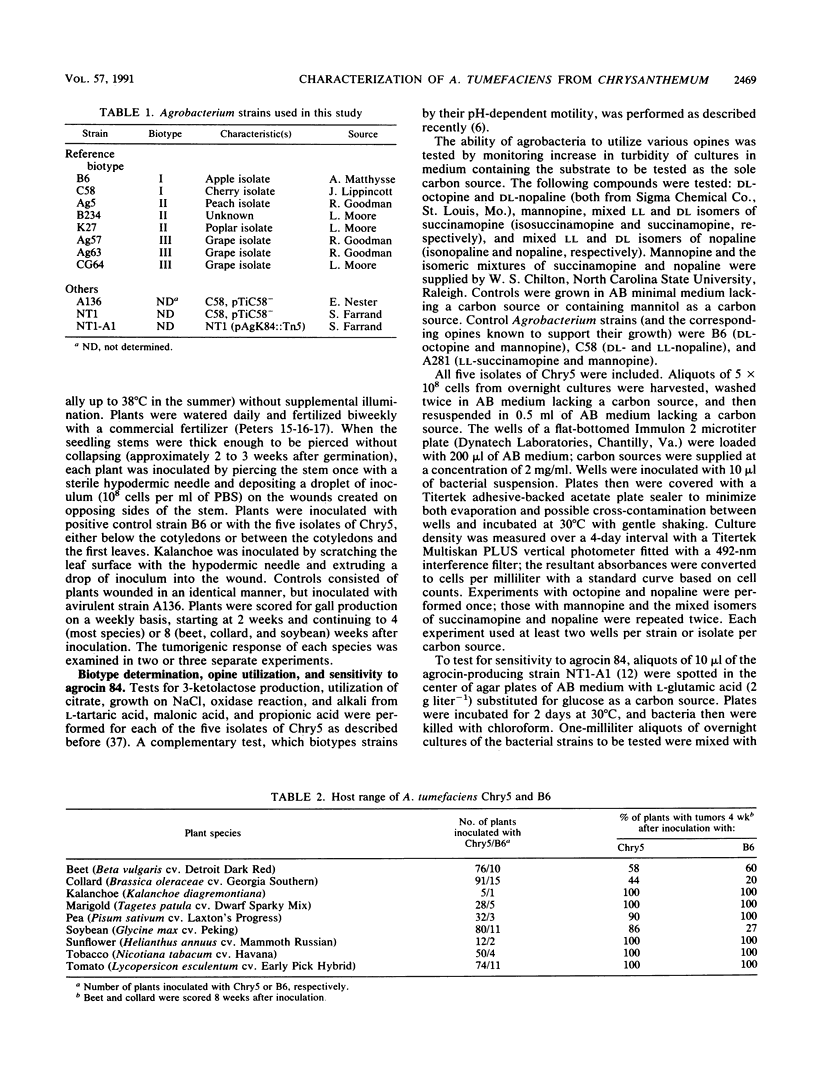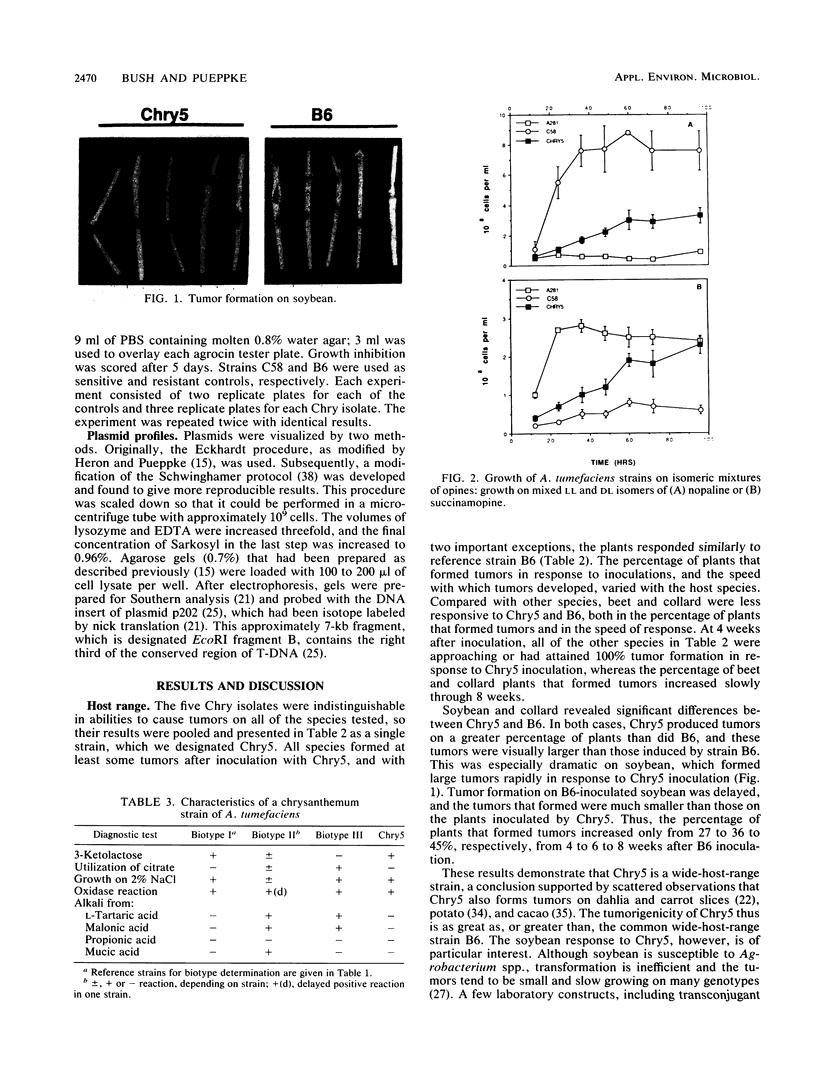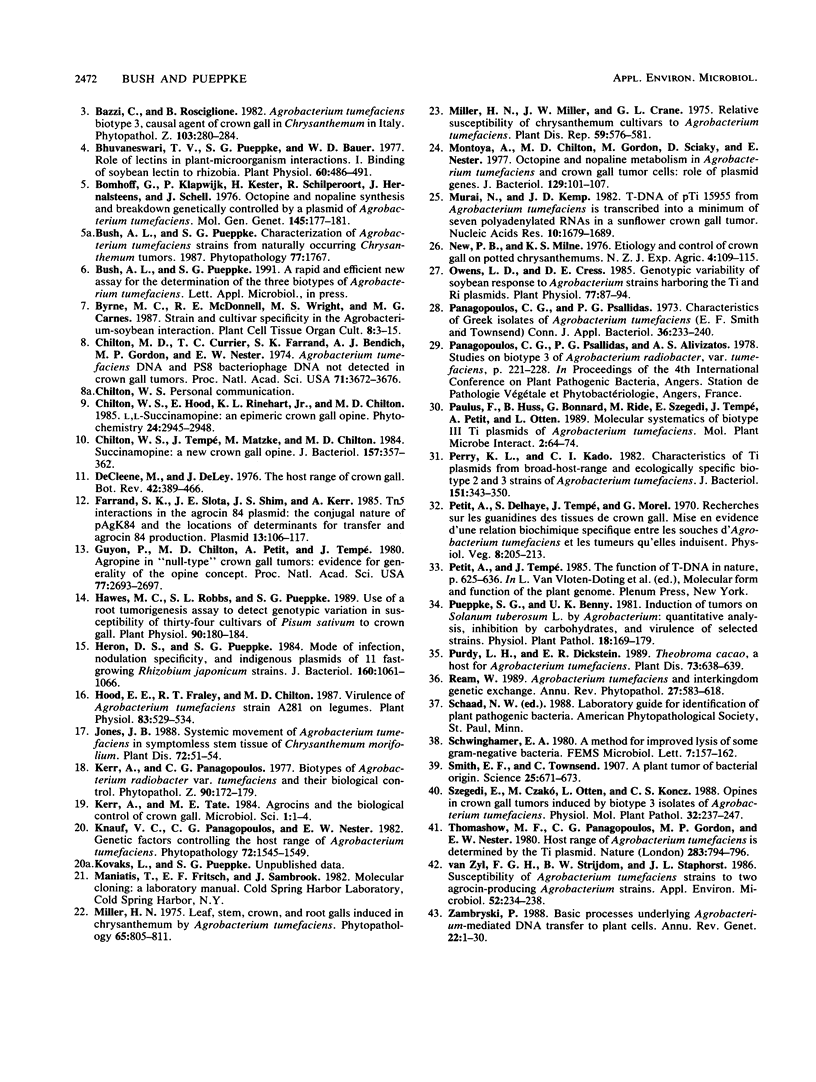Abstract
We characterized five isolates of Agrobacterium tumefaciens from naturally occurring galls on Chrysanthemum morifolium. The isolates are similar, possibly identical, members of a single strain of A. tumefaciens that we designate Chry5. The strain is a biotype I, as indicated by its response to both newly described and traditional biotype tests. Chry5 produces tumors on at least 10 plant species. It is unusual in its ability to form efficiently large tumors on soybean (Glycine max), a species normally refractory to transformation. Chry5 is unable to utilize octopine or mannopine as a carbon source. Although Chry5 can catabolize a single isomer each of nopaline and succinamopine, it differs from other known nopaline and succinamopine strains in its insensitivity to agrocin 84. This pattern of opine catabolism is unique among Agrobacterium strains examined to date. All five isolates of Chry5 contain at least two plasmids, one of which shares homology with pTiB6.
Full text
PDF




Images in this article
Selected References
These references are in PubMed. This may not be the complete list of references from this article.
- Bhuvaneswari T. V., Pueppke S. G., Bauer W. D. Role of lectins in plant-microorganism interactions: I. Binding of soybean lectin to rhizobia. Plant Physiol. 1977 Oct;60(4):486–491. doi: 10.1104/pp.60.4.486. [DOI] [PMC free article] [PubMed] [Google Scholar]
- Bomhoff G., Klapwijk P. M., Kester H. C., Schilperoort R. A., Hernalsteens J. P., Schell J. Octopine and nopaline synthesis and breakdown genetically controlled by a plasmid of Agrobacterium tumefaciens. Mol Gen Genet. 1976 May 7;145(2):177–181. doi: 10.1007/BF00269591. [DOI] [PubMed] [Google Scholar]
- Chilton M. D., Currier T. C., Farrand S. K., Bendich A. J., Gordon M. P., Nester E. W. Agrobacterium tumefaciens DNA and PS8 bacteriophage DNA not detected in crown gall tumors. Proc Natl Acad Sci U S A. 1974 Sep;71(9):3672–3676. doi: 10.1073/pnas.71.9.3672. [DOI] [PMC free article] [PubMed] [Google Scholar]
- Chilton W. S., Tempé J., Matzke M., Chilton M. D. Succinamopine: a new crown gall opine. J Bacteriol. 1984 Feb;157(2):357–362. doi: 10.1128/jb.157.2.357-362.1984. [DOI] [PMC free article] [PubMed] [Google Scholar]
- Farrand S. K., Slota J. E., Shim J. S., Kerr A. Tn5 insertions in the agrocin 84 plasmid: the conjugal nature of pAgK84 and the locations of determinants for transfer and agrocin 84 production. Plasmid. 1985 Mar;13(2):106–117. doi: 10.1016/0147-619x(85)90063-0. [DOI] [PubMed] [Google Scholar]
- Guyon P., Chilton M. D., Petit A., Tempé J. Agropine in "null-type" crown gall tumors: Evidence for generality of the opine concept. Proc Natl Acad Sci U S A. 1980 May;77(5):2693–2697. doi: 10.1073/pnas.77.5.2693. [DOI] [PMC free article] [PubMed] [Google Scholar]
- Hawes M. C., Robbs S. L., Pueppke S. G. Use of a Root Tumorigenesis Assay to Detect Genotypic Variation in Susceptibility of Thirty-four Cultivars of Pisum sativum to Crown Gall. Plant Physiol. 1989 May;90(1):180–184. doi: 10.1104/pp.90.1.180. [DOI] [PMC free article] [PubMed] [Google Scholar]
- Heron D. S., Pueppke S. G. Mode of infection, nodulation specificity, and indigenous plasmids of 11 fast-growing Rhizobium japonicum strains. J Bacteriol. 1984 Dec;160(3):1061–1066. doi: 10.1128/jb.160.3.1061-1066.1984. [DOI] [PMC free article] [PubMed] [Google Scholar]
- Hood E. E., Fraley R. T., Chilton M. D. Virulence of Agrobacterium tumefaciens Strain A281 on Legumes. Plant Physiol. 1987 Mar;83(3):529–534. doi: 10.1104/pp.83.3.529. [DOI] [PMC free article] [PubMed] [Google Scholar]
- Kerr A., Tate M. E. Agrocins and the biological control of crown gall. Microbiol Sci. 1984 Apr;1(1):1–4. [PubMed] [Google Scholar]
- Montoya A. L., Chilton M. D., Gordon M. P., Sciaky D., Nester E. W. Octopine and nopaline metabolism in Agrobacterium tumefaciens and crown gall tumor cells: role of plasmid genes. J Bacteriol. 1977 Jan;129(1):101–107. doi: 10.1128/jb.129.1.101-107.1977. [DOI] [PMC free article] [PubMed] [Google Scholar]
- Murai N., Kemp J. D. T-DNA of pTi-15955 from Agrobacterium tumefaciens is transcribed into a minimum of seven polyadenylated RNAs in a sunflower crown gall tumor. Nucleic Acids Res. 1982 Mar 11;10(5):1679–1689. doi: 10.1093/nar/10.5.1679. [DOI] [PMC free article] [PubMed] [Google Scholar]
- Owens L. D., Cress D. E. Genotypic variability of soybean response to agrobacterium strains harboring the ti or ri plasmids. Plant Physiol. 1985 Jan;77(1):87–94. doi: 10.1104/pp.77.1.87. [DOI] [PMC free article] [PubMed] [Google Scholar]
- Panagopoulos C. G., Psallidas P. G. Characteristics of Greek Isolates of Agrobacterium tumefaciens (E. F. Smith & Townsend) Conn. J Appl Bacteriol. 1973 Jun;36(2):233–240. doi: 10.1111/j.1365-2672.1973.tb04096.x. [DOI] [PubMed] [Google Scholar]
- Perry K. L., Kado C. I. Characteristics of Ti plasmids from broad-host-range and ecologically specific biotype 2 and 3 strains of Agrobacterium tumefaciens. J Bacteriol. 1982 Jul;151(1):343–350. doi: 10.1128/jb.151.1.343-350.1982. [DOI] [PMC free article] [PubMed] [Google Scholar]
- Smith E. F., Townsend C. O. A PLANT-TUMOR OF BACTERIAL ORIGIN. Science. 1907 Apr 26;25(643):671–673. doi: 10.1126/science.25.643.671. [DOI] [PubMed] [Google Scholar]
- Zambryski P. Basic processes underlying Agrobacterium-mediated DNA transfer to plant cells. Annu Rev Genet. 1988;22:1–30. doi: 10.1146/annurev.ge.22.120188.000245. [DOI] [PubMed] [Google Scholar]
- van Zyl F. G., Strijdom B. W., Staphorst J. L. Susceptibility of Agrobacterium tumefaciens Strains to Two Agrocin-Producing Agrobacterium Strains. Appl Environ Microbiol. 1986 Aug;52(2):234–238. doi: 10.1128/aem.52.2.234-238.1986. [DOI] [PMC free article] [PubMed] [Google Scholar]




